Despite my best intentions, I was off to a late start, as usual. It was midafternoon—late afternoon, maybe—by the time I launched the boat and started rowing up Hanson Bay. I wasn’t sure because I hadn’t brought a watch. Given the jumble of gear I had hurriedly transferred from car to boat after launching, there were probably other things I hadn’t brought. And there were also things I had packed in such a rush that they wouldn’t be seen again until I unloaded the boat to trailer it home a in a week. But now that the boat was in the water, none of that mattered. I had finally managed to find my way to Ontario’s Lake of the Woods, twenty years after I’d first seen a chart of it.
After parking the car, I took what little cash I had on hand into the marina store in a gesture to bolster the local economy, but I didn’t see much that looked useful. I finally bought a candle-powered flying lantern made of tissue paper—a red one, of course: a red lantern is the traditional award for a race’s last finisher, which suited my intentions for a languid cruise quite nicely. I handed over my last few Loonie coins, collected my change, and headed back to the boat.
“SOAR TO NEW HEIGHTS!” the lantern packaging read—and, this being Canada, “S’ENVOLENT VERS DE NOUVEAUX SOMMETS!” The picture on the label showed a trio of glowing red tissue-paper spheres floating through a starry night above a skyline of spruces and pines. Airborne candles in the north woods? Last summer, a three-day stopover in Georgian Bay’s Churchill Islands had given me a front-row seat to a major forest fire. This year I’d be able to start my own.
“YOU WON’T BELIEVE YOUR EYES!” the label continued, “VOUS N’EN CROIREZ PAS VOS YEUX!” Maybe so, maybe not. I pulled the flimsy lantern out of its packaging and chucked it in the back seat of the car, then slid my Lake of the Woods chart into the now-empty plastic bag and pressed the seal closed again. Look at that, I thought. VOILÀ! A waterproof chart case.
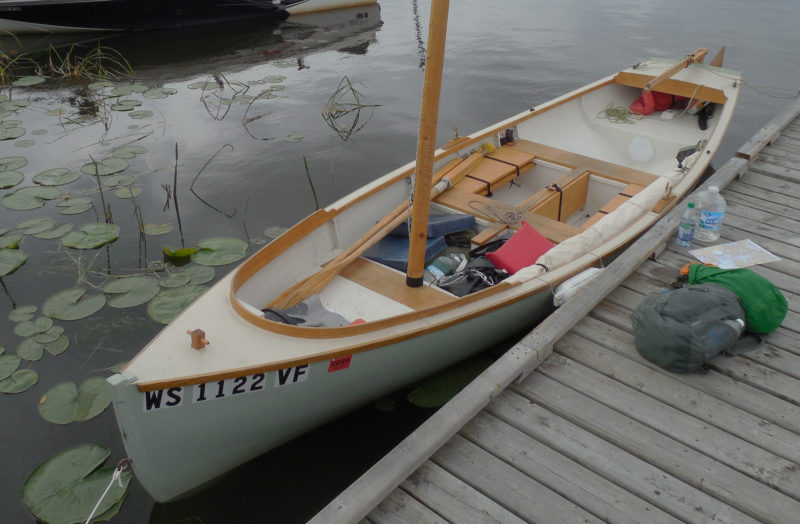 Photographs by the author except as noted
Photographs by the author except as notedMy 18’ Kurylko-designed Alaska was nearly ready for my week-long exploration of Ontario’s Lake of the Woods, but I’ve learned to not cast off until everything is neatly stowed. Proper trim for solo sailing demands that heavy gear, along with 100 lbs of ballast in four 25-lb bags of steel shot, is loaded forward, at the foot of the mast. The small backpack and dry bag on the dock will be kept at hand under the Alaska’s small aft deck, protected from spray and rain, and within easy reach of the helm.
The boat was waiting at the dock, everything loaded and lashed down. Dry bags stuffed with books, clothes, food, and camping gear. Water jugs. Anchor and bucket, chain and line. Rudder secured on the pintles, tiller bolted in place. Mast stepped. Yard and sail bundled along the port gunwale, ready to be hoisted. Downhaul rigged. Foam cushions for cockpit lounging. There didn’t seem to be any excuses left. I uncleated the docklines, stepped aboard, and shoved off.
I rowed easily up the bay, a mile-long finger of water so narrow that raising the sail would have been a waste of time. Even as heavily laden as the boat was, I didn’t feel the weight once we were moving; a Whitehall-type hull carries a load gracefully. Before long I had reached the open waters of Sabaskong Bay to find a light wind from the southeast and a broad scattering of thickly wooded islands in every direction. I brought the bow into the wind and raised the sail.
There wasn’t much of a breeze, but it was enough to keep me moving. Barely. At my current light-air, red-lantern pace, the lake seemed enormous—no, it was enormous. On the 1:150,000 Lake of the Woods chart tucked under a strap on the rowing thwart, Sabaskong Bay alone fit comfortably under the palm of my hand, ten miles crammed into four inches: four hours of sailing, maybe five. But the world here was to be understood not with a glance at a chart, but only moment by moment, island by island, mile after slow mile. That’s what I had come for.
My plan was to head northeast across Sabaskong Bay and into Turtle Lake, a connecting bay with an entrance channel so narrow that its opposing shores merged into a single line on the chart. Once through, another mile of sailing would bring me to the northern end of Turtle Lake, where I hoped to camp. Here the chart showed a strip of land perhaps 25 yards wide separating Turtle Lake from Whitefish Bay to the north—a dead end. Or was it?
A thick black line labeled “Canal” connected Turtle Lake to Whitefish Bay, at least on paper. But I knew the canal had been filled in years ago, and I’d heard that it had later been replaced with a hand-operated marine railway capable of hauling small boats over the gap with a cart and winch. But reports about the current state of affairs were inconclusive, even contradictory. The railway would soon be removed by the Ministry of Natural Resources… it had already been removed… it was still in place but no longer functional, as the cart apparently had run off the end of the rails and sunk into the lake, leaving only an empty set of rails to bridge the gap. Who knew what to believe?
If I could get my boat across the portage at Turtle Lake, I would be able to circumnavigate the entire Aulneau Peninsula, a 600-square-mile land mass that filled the center of Lake of the Woods like a small continent, its convoluted shoreline offering a muddle of channels and islands and back bays that were themselves filled with even smaller islands, a confusion of mazes within mazes. Circling the Aulneau would give me 100 miles of sail-and-oar cruising. But I wasn’t keen to manhandle 600 lbs of boat and gear over who knows what kind of terrain to begin.
When I had asked about the current state of the railway back in Hanson Bay, no one had been able to tell me anything. Local boaters seemed surprised I had even heard of it. After I failed to find anyone who had actually used it themselves, I gave up. The railway would either be there or it wouldn’t. Uncertainty is the essence of travel; everything else is tourism.
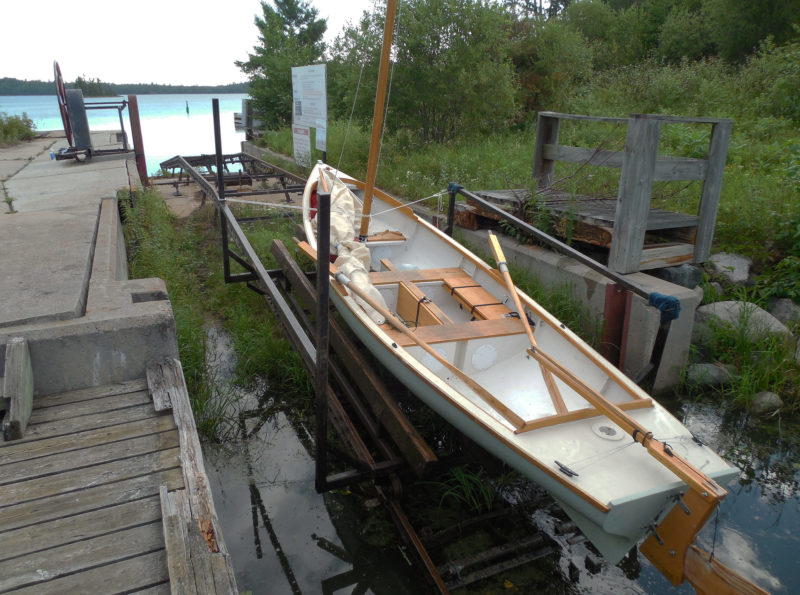
The gearing on the mechanism of the Turtle Portage Marine Railway provides enough mechanical advantage to make its big wheel, at upper left, easy to spin, and thus to pull the boat and cart up the tracks. An automatic brake holds the cart in place whenever the foot lever, just visible at the base of the wheel, is released. It’s a simple and effective system for transporting small boats.
The sun had sunk below the horizon well before I reached Turtle Lake, but I kept rowing through the long twilight after the faint breeze had dropped away to nothing. I continued into the entrance channel, passed a couple of small islands, and crossed Turtle Lake in the full darkness of a night lit only by stars. Twenty yards from the far shore I pulled out a flashlight and managed to find the buoys marking the entrance to the canal, or railway, or dead end—it was still impossible to say which.
And then, with the flashlight’s beam, mosquitoes. They swooped down on the boat in ravenous thick-thrumming clouds—biting, biting, biting, biting—swarming my face, my eyes, my nose, my ears, my feet. I pulled on my raincoat and rain pants, rowed at full speed to the channel’s end, splashed awkwardly to shore, and began to set up the tent in the dark with a rush of slapping and swearing, not even bothering to look around for the railway. Biting, biting, biting. My arms, legs, and face were smeared with blood. Mosquitoes crawled wriggling up my sleeves, under the brim of my hat, up the legs of my rain pants. Biting, biting. The air was thick with them, their buzzing the live-wire hum of a high-voltage transformer. Biting, biting, biting. I held my hand over my mouth and nose to avoid breathing them in, and still a dozen mosquitoes fluttered in my throat at each inhalation. I unzipped the tent, threw in whatever gear I could reach, and crawled in after it. I spent the next hour killing every mosquito that had found its way in. By the time I was done, the walls were covered in streaks of blood, and the floor was strewn with heaps of crumpled bodies.
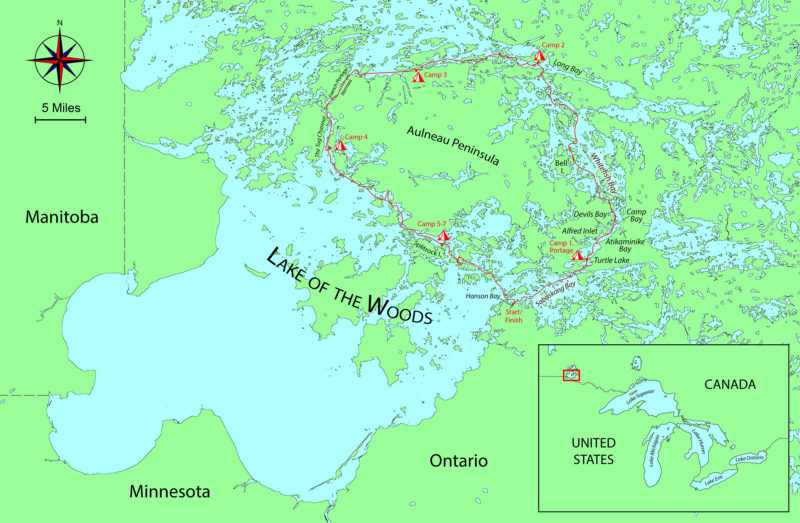 Roger Siebert
Roger Siebert.
In the morning the mosquitoes were gone. I crawled out of the tent and looked around. A rusty set of railroad tracks rose from the dark water, up and over the narrow isthmus, and down the other side. A sign—“Welcome to the Turtle Portage Marine Facility”—stood alongside the center of the railway, with a notice nailed on top of it:
Public Notification for a Category B Project Evaluation
The Ontario Ministry of Natural Resources and Forestry intends to decommission the Turtle Portage Marine Railway System in 2019. Maintenance and operation of the current system is cost prohibitive.
The cart was submerged deep in the water at the end of the track. The dock above it hung limp and half-submerged from its rotting pilings. The railway was knee-deep in weeds. It all looked distinctly unpromising. But when I spun the wheel that wound the cable onto the drum, the cart creaked slowly up the rails. I winched it all the way up and halfway down the other side for a test run. Decommissioned or not, it appeared to be functional.
Good enough. I manhandled the boat onto the cart, tied it to the rails, and winched it over the low rise separating Turtle Lake from Whitefish Bay, where I left it tied to the dock on the far side of the portage. Then I took down the tent, carried my gear to the boat, lashed it in place again, and finally winched the cart back up to the center of the railway for whoever might need it next. The sun was still low in the sky by the time I finished, and the surface of the lake was rippling and wavering under the first faint stirrings of a west wind. I cast off, rowed a few yards out, and raised the sail. My circumnavigation of the Aulneau Peninsula was underway.
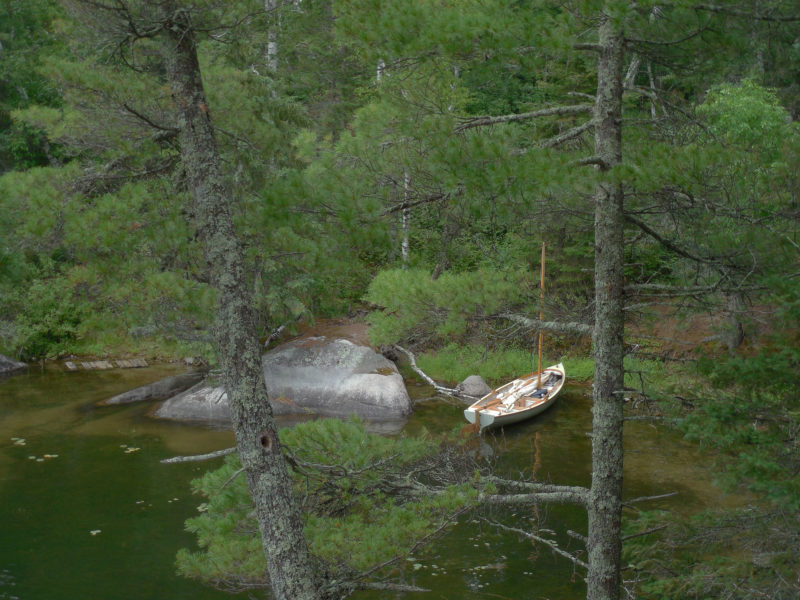
Lake of the Woods lies in the far southwestern reaches of the Canadian Shield, a fascinating geological region where glacier-scoured granite bedrock lies close to the surface. On my journey north through Whitefish Bay, I stopped at several unnamed islands to scramble up tall cliffs and domes of bare granite for a bird’s-eye view of my route.
The rest of the day was sublime, sailing a broad reach northward up Whitefish Bay past Alfred Inlet, Devil’s Bay, Atikaminike Bay, Camp Bay. I jibed and slalomed my way through chains of rocky islands that rose from the water like long-forgotten ruins, and stopped ashore for a view from one granite-slabbed summit before continuing on. A group of white pelicans bobbing on the surface eyed me suspiciously but declined to take wing as I passed. A lone cottage stood tucked away on its own tiny island above an empty dock. I saw no other boats, heard no motors.
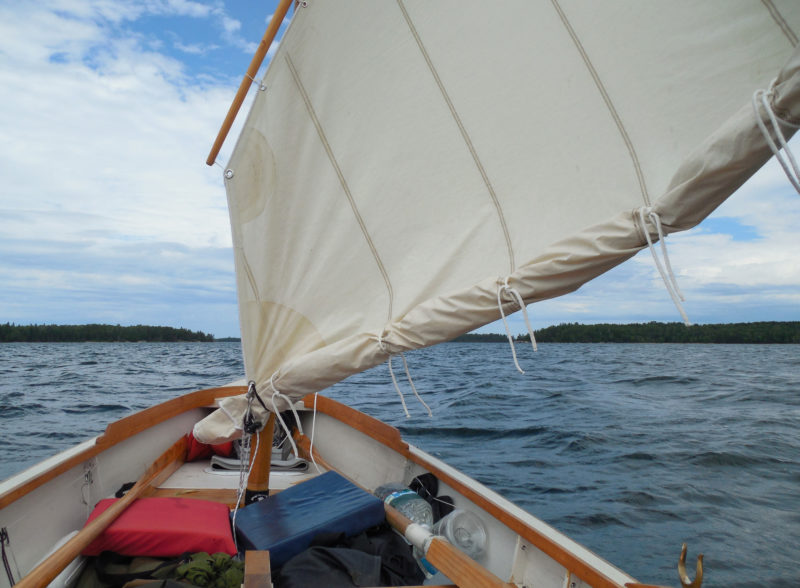
I had my sailmaker, Stuart Hopkins of Dabbler Sails, put in an extra-deep third reef that’s not specified in the plans for the Alaska. Since the foot of a boomless sail comes under considerable strain from the sheet, Stuart installed continuous reef bands rather than individual reef points. With the third reef in, the boat performs very well off the wind—a good thing for this trip, because the wind was gusty and strong from the west all week.
Late in the morning I rounded the easternmost point of the Aulneau Peninsula, rowing through a narrow passage overrun with lily pads to emerge into a gusty southwest wind that swept across the open water in a flurry of whitecaps. I fought my way to windward into the lee of an island thick with tall pines, where I dropped the sail and considered my options. A southwest wind was perfect for this northward leg of my journey—but a southwest wind gusting to 25 or 30 miles per hour was hardly ideal. There was plenty of daylight left, though, and an almost infinite array of options for ducking into shelter if I needed to. After thinking it over, I raised the sail and continued north triple-reefed, the 85-sq-ft mainsail reduced to well under half its full size.
Reef early, reef often, I reminded myself, leaning back on the sternsheets with the tiller tucked casually under my arm. The boat was making an easy 4 or 5 knots, I guessed, and remained perfectly docile and well-mannered, surging ahead and surfing the wave crests, showing no tendency to broach. Of course, speed is a relative thing; even with the wind on the port quarter, our pace was barely faster than a brisk walk. Not that I was in any hurry to put miles behind me.
After an hour or two I set my bungee-and-line autopilot and started slicing thin discs from a sweet potato to eat raw—call that lunch. As I rounded the northern tip of Bell Island, the last slice of sweet potato in hand, a bald eagle swung down from a treetop to snatch a fish from the water not ten yards off the port bow, then lurched clumsily into the air with a startled glance as I sailed past. “VOUS N’EN CROIREZ PAS VOS YEUX!” I thought.
Island after island passed by as I kept a close eye on the chart—lacking any navigation gear more sophisticated than a chart and hand compass, I’m careful to keep track of where I am as I go. Better that than to try to puzzle out a location after you’re already lost. And there was plenty of room for getting lost, or at least temporarily displaced, on Whitefish Bay.
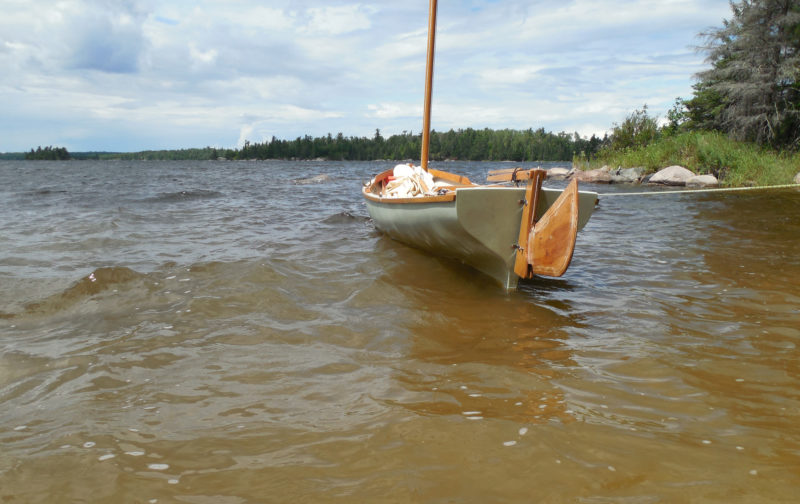
Heading west along the top of the Aulneau Peninsula on the third day, I had to fight strong gusty headwinds. I eventually gave up, and anchored briefly off this sandy beach for lunch before rowing to a more sheltered anchorage nearby to wait for the wind to die down. Later that evening, I sailed another 10 miles in much more pleasant conditions. I consider an open calendar and an absolute refusal to stick to a pre-set schedule to be my most effective safety measures.
By evening I had reached the western end of Long Bay, where I tied up in a sandy backwater and took my tent ashore. The Aulneau lay somewhere out of sight now, six or eight miles off my route, hidden behind a tangle of intervening islands. As I ate my supper, a beaver swam by dragging an entire birch sapling through the water. Catching sight of me on shore, he ducked beneath the surface without so much as a slap of his tail, taking the entire mess of branches with him.
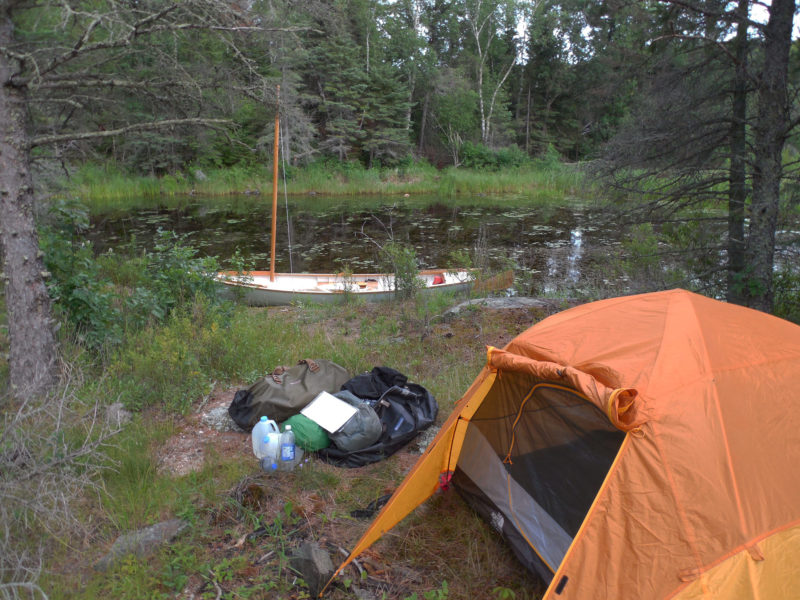
Two otters approached within arm’s reach, then scampered off into the woods, as I pulled into this quiet backwater along the north side of the Aulneau. I suspected the mosquitoes would not have been quite so welcoming in such a protected bay, so I carried my gear ashore and set up my tent for the night. In Canadian-Shield terrain, a freestanding tent makes life much easier, because it’s rare to find a campsite where the ground will take tent stakes.
From Long Bay my route would take me west along the northern edge of the Aulneau for forty miles before rounding the corner and turning south again. Forty miles of headwinds—two days, I told myself, maybe more. Probably more.
The wind grew stronger as the day went on. The first reef went in before noon, the second a few minutes later. Before long I could have used the third reef again, but I knew the shorter luff of the triple-reefed sail wouldn’t have done well to windward. I bashed along for an hour or two through a haze of cold spray, easing the sheet in gusts, hoping for the wind to drop. Finally I missed a tack, then missed again, and found myself too close to shore for a third try. I hurriedly doused the sail, dropping the yard on the gunwale with a clatter, and took to the oars. With the mast still up, I was practically rowing in place against the wind. It took me ten minutes of hard rowing to move twenty yards. As soon as I could, I pulled into a sheltered bight in the lee of a tall island, dropped the anchor, and settled in to wait out the wind.
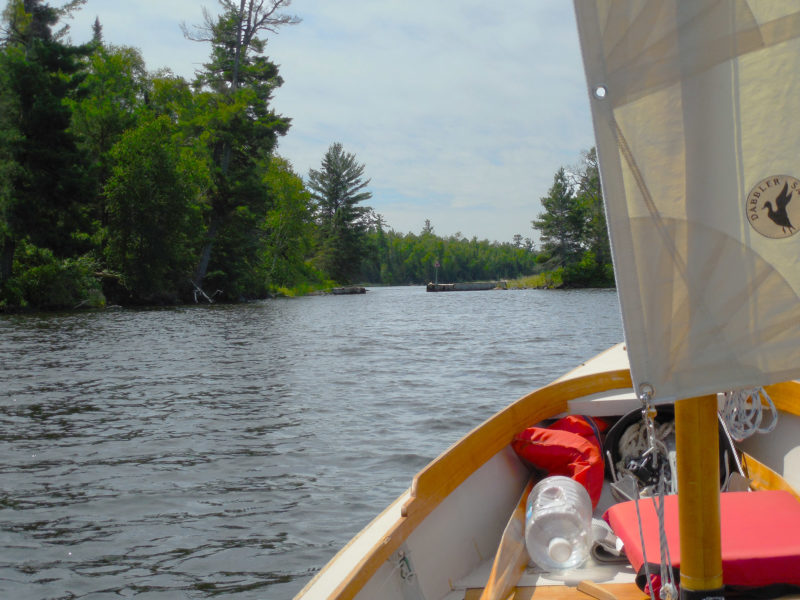
Although I guessed that French Portage Narrows wouldn’t involve an actual portage, it wasn’t until the narrow passage came into view that I knew this for certain. With the Internet always at my fingertips at home, I could have found out before my trip, but I try to avoid gathering too much information for my solo trips ahead of time. I prefer to discover things for myself as I go.
I had come eight miles, more or less, and might make a few more miles in the evening if the wind died down. I adjusted my mental schedule to account for the strength of the prevailing westerlies: five days to cross the top of the Aulneau Peninsula, then another three days back to Hanson Bay. My red-lantern award was secure.
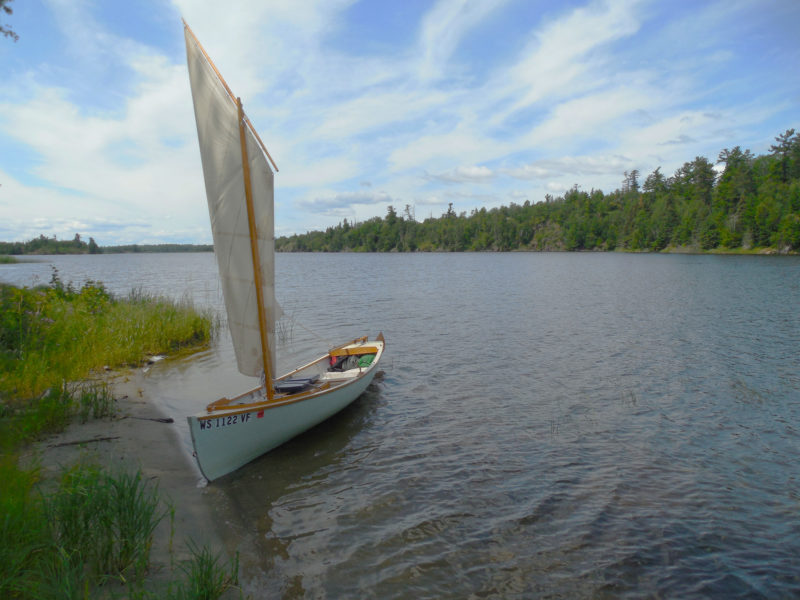
It’s hard for a solo sailor to see what his boat looks like from the outside. When I saw this sandy beach south of French Portage Narrows, I decided to stop and have a look for myself. Not bad, I decided, not bad at all.
Pleasant days can make boring stories, but even so, I wouldn’t trade them away for more interesting times. For two more days I sailed on across the top of the Aulneau, tacking westward in mild breezes, following each sunset to its gentle conclusion in long-lingering twilight. I rowed past snapping turtles the size of manhole covers sunning themselves on slabs of rock, sailed past herons and deer and white-whiskered otters. I stopped at sandy beaches to swim under the hot sun. After lunch each day I let the boat drift in a quiet cove while I read a few pages from whichever book I had on hand. Aldo Leopold’s essay “A Man’s Leisure Time” seemed particularly serendipitous:
At first blush I am tempted to conclude that a satisfactory hobby must be in large degree useless, inefficient, laborious, or irrelevant…a defiance of the contemporary… an assertion of those permanent values which the momentary eddies of social evolution have contravened or overlooked.
Leopold would have understood what I was doing here, aboard a boat it had taken me seven years to build, perhaps stretching even his idea of “laborious” and “inefficient.” He would have known, too, why I carry oars instead of an engine, a chart and compass instead of an iPhone or chart plotter. A defiance of the contemporary—exactly so, I thought. And mile by slow mile the journey continued, past the crooked corners of the world that reveal themselves to those who have learned how not to hurry past. Light the red lantern and hoist the sail, brother. Hoist the sail.
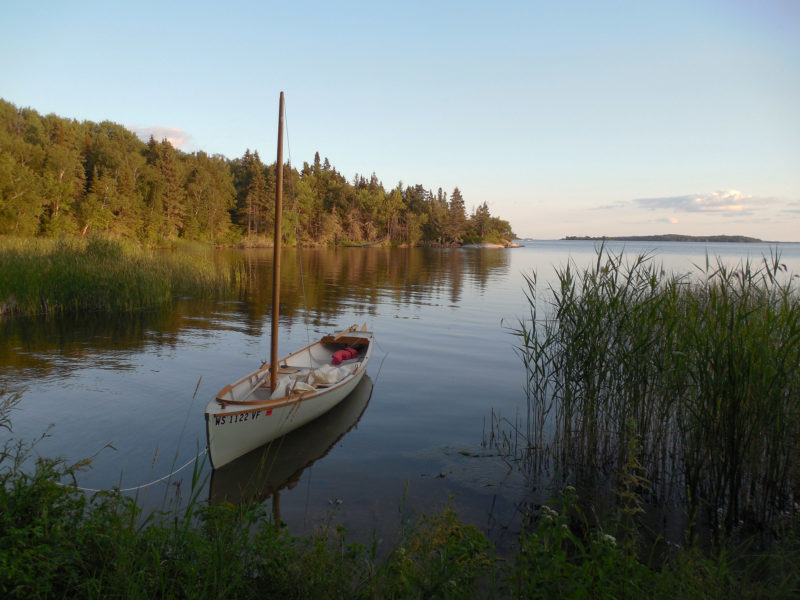
To camp for my last night alone on Lake of the Woods, I found a perfectly protected sandy beach on at the southern end of The Tug Channel. In these conditions, the 3-lb Northill seaplane anchor I rigged to hold the boat off the beach was overkill.
On my fourth day out of Hanson Bay, I rounded the northwest corner of the Aulneau at last and turned south down its western shore. I spent the morning ghosting along in light winds, sometimes becalmed entirely but not ambitious enough to row. I passed lazily through the long passage of French Portage Narrows and on to The Tug Channel, where the wind returned at last.
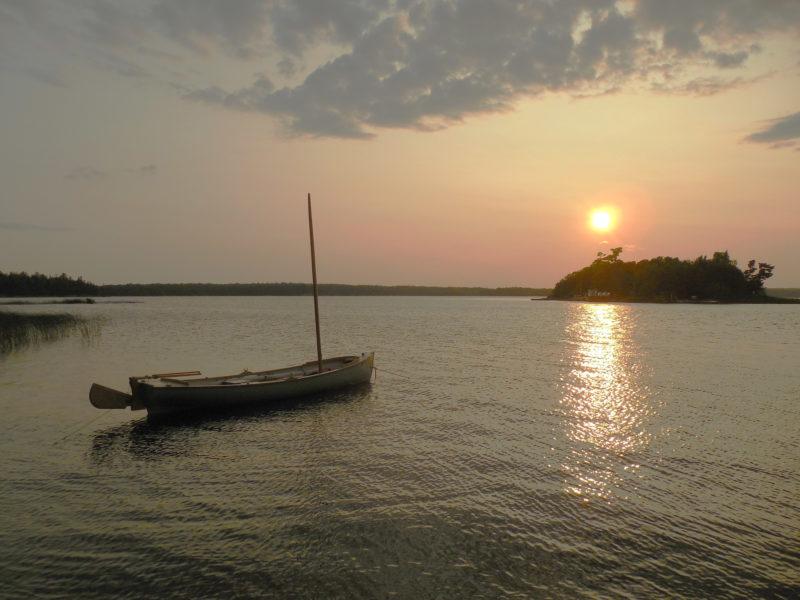
During my stay with friends at their cabin near Splitrock Island at the end of my journey, we found time for a long light-air circumnavigation of their island one evening. We returned to their beach near sunset, and I anchored for the night above a sandy bottom in knee-deep water.
That night I camped ashore on a sandy beach fronted by a wall of reeds eight feet high, a perfect screen to hide my bright orange tent. After supper I took the boat out again, empty of gear, sailing just to be sailing, unburdened of all aspirations but this: to inhabit for a while the conjunction of here and now: the surging rush of the waves, the hiss of water rushing past the hull, the pull of the sheet in my hand. By the time I returned to shore, the moon had climbed well over the horizon.
 Don Engen
Don EngenThe morning I set out on the final leg of my journey back to Hanson Bay, my friends at Splitrock Island captured this photo from the end of their dock. Despite the obvious low freeboard, the Alaska’s reserve stability will let the hull heel only so far before hardening up.
I opened a can of peaches for supper and leaned back against the trunk of a red birch at the edge of the beach to watch the night unfold. A whisper of breeze slipped through the leaves above me. A pair of barred owls called from the forest at my back, and called again. A mink scampered along the rocky shore at my feet, chasing its own shadow through the moonlight. And just off the beach the boat floated on water so dark and calm that it mirrored the stars, a pale green hull adrift in the night sky. “S’ENVOLENT VERS DE NOUVEAUX SOMMETS!” I thought.![]()
Tom Pamperin is a freelance writer who lives in northwestern Wisconsin. He spends his summers cruising small boats throughout Wisconsin, the North Channel, and along the Texas coast. He is a frequent contributor to Small Boats Monthly and WoodenBoat.
If you have an interesting story to tell about your adventures with a small boat, please email us a brief outline and a few photos.
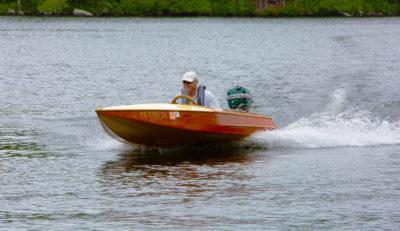
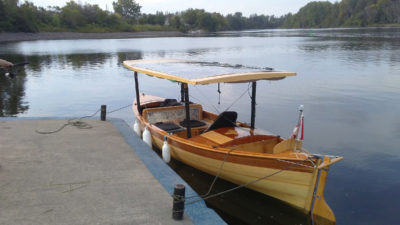
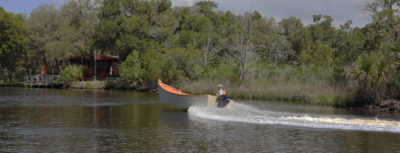
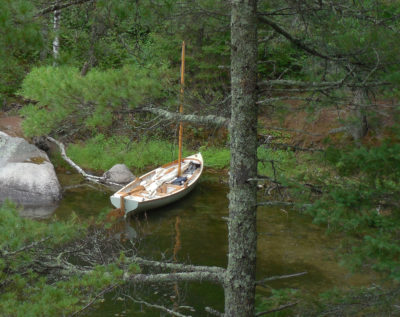
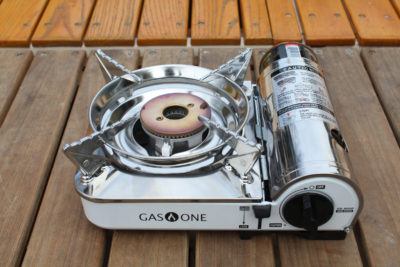
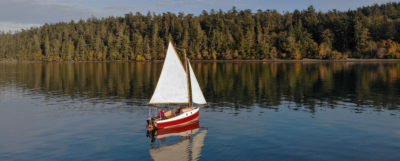

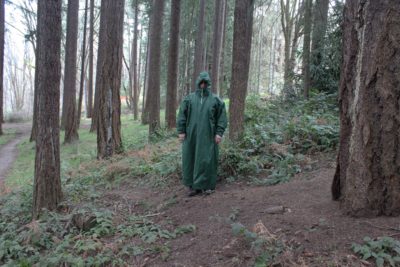
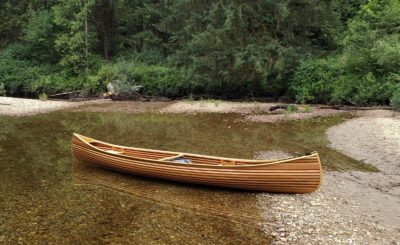

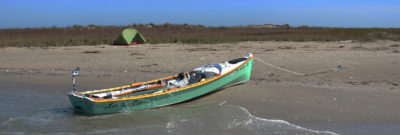
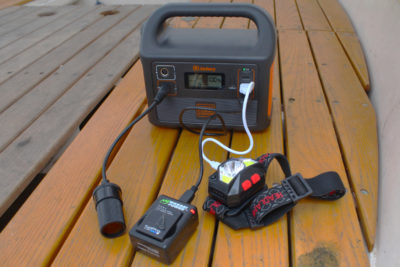


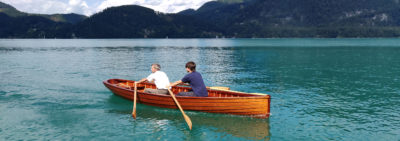
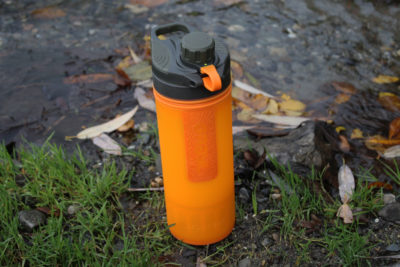
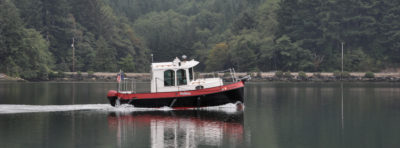
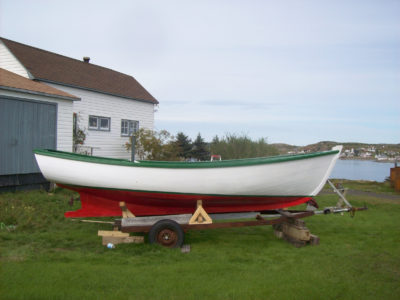



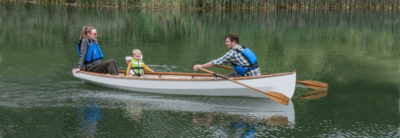
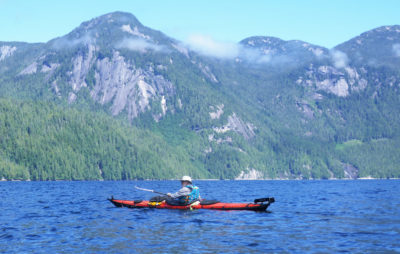
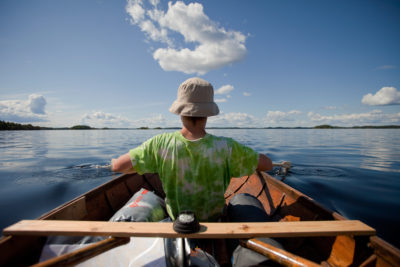
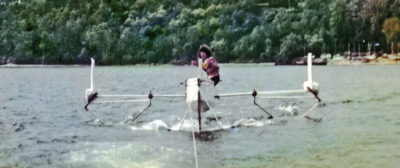
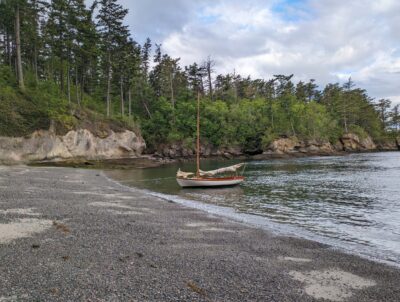
The author has demonstrated his worldly knowledge and experience and put me in my place with his use of French in several places. Since I neither read or speak it I hope future articles by any author will take into account a mere simpleton such as myself who might like to fully understand what the author wants to say.
Ted,
I’m sorry the French phrases annoyed you; I certainly didn’t intend to “put anyone in his place.” I admit that my own French is extremely limited, too, but if you re-read the 3rd and 4th paragraphs, you’ll find each French phrase is merely a translation of the English phrases from the lantern label. In Canada, labels and signs are required to appear in both French and English. Those are the same French phrases that appear later in the article in different contexts.
Great story, well told, Tom!
About 35 years ago, I chartered a keel boat ( a C&C 29 if memory serves) out of Kenora at the north end of the Lake and took my brothers and brother-in-law for a week’s cruise. The scenery was magnificent and we had a good time but I found the sailing stressful due to the tight quarters and zillions of rocks that threatened that deep keel at every tack. A sail-and-oar boat is a much more sensible craft for such an endeavor.
Thanks for the comment, Alex. Reminds me I still need to order a copy of your book, Becoming Coastal.
All those tides and currents you deal with on the West Coast are unfamiliar territory to me so far. I wanted to explore a little more toward Kenora, farther north on Lake of the Woods, but maybe it’s better to leave something for the next trip, eh?
Absolutely. With the number of islands in Lake of the Woods, the total length of shoreline in the lake must be almost fractally infinite. Thousands of miles, I would guess.
I had to look it up: total shoreline is estimated at 25,000 miles, not counting the islands (with them included, it’s 65,000)–enough miles to take you around the world and then some. I’m guessing another trip or two here might be possible.
Great article. I feel challenged to push the envelope when I read about such a fine adventure.
For ballast in a small boat I like water in bags or totes. The cubic polyethylene water totes are good, and usually are available in one-gallon, 2.5-gallon, and five-gallon sizes. The advantage over lead, rock, or sandbags is the neutral buoyancy in case of swamping. The ballast won’t carry your boat to the bottom. The flexibility of the totes lets them fit into awkward spots. The disadvantage is that they are bulky and don’t provide as much righting moment as denser materials. If sailing on the salt chuck, they can become part of your fresh water supply.
Water weighs about 8 lbs. per gallon.
Sure, water ballast would be another way to do it, with the advantages you mention. I chose steel shot because keeping the ballast more compact allows it to fit neatly under the lashed-down dry bags in the forward part of the compartment, with no fears of ballast shifting around or even (I suspect, but have not verified) falling out during a capsize). Steel shot also takes up far less space aboard, allowing me to keep everything but the “cargo area” completely clear. 12 gallons of water would take a lot of space, and the Alaska is not a large boat!
Thanks, Tom, I really enjoyed that! So refreshing to read your low-tech, don’t-overplan approach, which I share. Great Aldo Leopold quote.
Thanks, Osbert. Much appreciated. Still sailing your Walkabout?
Incredible that you made the voyage, Tom, with only a 1:150,000 map, a compass, and your eyes. Did you purposely use that scale, and not opt for charts more close-in? With all those myriad islands to throw you off, I don’t know how you managed. Looking level at a cove or inlet or island from a small boat is so much different than a map view of looking straight down. So many times while sailing, I’ll be looking at Such and Such, and I’ll say to myself, Yep, that surely must be So and So, for sure, and I’ll check the GPS only to learn I’m not anywhere near So and So. Many thanks for recording your intrepid voyage in words and pictures.
Brad,
Thanks for the comment. As far as the large-scale chart, for one thing, paper charts cost about $20 each… 🙂
I’ve also found that it’s hard to hold an overall sense of a place if you’re piecing together smaller charts, which can quickly clutter up the cockpit of an open boat. The 1:150,000 scale meant I could do this Lake of the Woods trip with one chart. I found it worked pretty well, actually–there’s enough detail because there are very few (none?) areas there that would be dangerous for a boat with a 7″ draft, like mine. It can get confusing at times, but there are some little visual/mental tricks I’ve picked up in 25+ years for learning to see and understand features more clearly from a small boat, and match them to the map.
For trips on Georgian Bay, it’s an entirely different story. I have the 1:200,000 overall chart of Georgian Bay for the big picture, but there are so many rocks and shoals (exposed to big fetches) that I use a much more detailed chart while sailing, generally 1:20,000 or so. That allows me to find many more areas to explore, which I wouldn’t always want to risk going into with a less detailed chart.
Nice story, Tom, I enjoyed it fully.
Tom Pamperin, thank you for an inspiring article that makes me want to get out and see new wild spaces. The style of writing too is inspirational, reflecting a willingness to explore more than just new lakes. Truly “S’envolent vers de nouveaux sommets.”
Thanks for the kind words–as always, remember that I had help from a good editor here at Small Boats. But by all means, I hope you find your own trips and areas to explore.
Explore more than just new lakes. Truly “S’envolent vers de nouveaux sommets.”
Tom, your circumnavigation of the Alneau is something I have wanted to do for years. I have spent many summer vacations in and around Sioux Narrows exploring the lake. Whitefish Bay is my favorite part of the lake due to the exceptionally clear water and sparsity of cottage development, but as you say there are many miles of the lake to the north that would be worth visiting on a subsequent trip.
I have also traversed a lot more of the lake in my cold-molded 26′ keelboat during the LOWISA events, when we had it moored at Northern Harbour near Kenora. However, as one reader commented, one needs to be constantly on rock lookout in a deep-draft boat, and the safest approach for sailing at speed is to stick to the buoyed navigation channels.
We wound up moving our keelboat to Lake Winnipeg to be closer to our home in Clandeboye Manitoba, but this open, relatively shallow lake is utterly different in character from the island- and bay-studded Lake of the Woods, which, in my opinion, is the finest freshwater lake in the world for the type of cruising you have done. To this end, I am now building a 17 Shilling sailboat, from plans by Phil Swift of Willow Bay Boats in Windermere, UK. This is a ballasted, centerboard yawl with a cabin that would permit sleeping aboard, avoiding the omnipresent mosquitoes and eliminating the need to pitch a land-based tent every night. However the projected weight of the boat in ballast is 1120 pounds, and a full complement of cruising gear could easily push that to 1500, so having the marine railway at the north end of Turtle lake up and functioning would be critical.
I have visited this facility several times in the past, and have seen boats the size of 17′ outboard runabouts with 90 hp and larger outboards negotiate it successfully, so if the thing were functioning properly it would certainly be up to the task. As a Canadian, I am very disappointed to see the stance that the Ontario Ministry of Natural Resources has adopted on this issue – this is by no means as complicated as something like the locks on the Trent-Severn waterway, and repairs and upkeep on this simple facility are certainly not going to break the budget of the Ontario government. From the looks of the photograph you supplied, some of the rotted wood on the approach needs replacement, and the steel components, as you say are in good working order. Any repairs to this structure could be done over the winter by any welding shop in Kenora, and the parts moved to Turtle lake by barge if they are too large to be transported in smaller boats. Surely this is a facility worth maintaining? Perhaps Transport Canada ought to get involved to maintain this waterway as navigable route for craft larger that canoes?
I’d love to see the Turtle Portage Railway stay in operation. Without it, getting to the southern end of Whitefish Bay and back–a near circumnavigation–would take about 12-14 days in a boat like mine.
The south side was in pretty bad shape as far as docks go (there weren’t really any left)–the photos don’t really show that. The north side had good solid docks and was in much better shape. But I guess the whole thing will probably be gone next summer.
I love the Canadian Shield area—rocks, trees , rivers and lakes—and your boat is gorgeous. A great account of a lovely trip. The mosquitoes, on the other hand, would drive me out.
With a friend on a northern canoe trip we set up the tent on a grassy area by a stream. Coming back in the evening we encountered the same sucking insect issues as you; ran into the tent as fast as possible and then spent a lot of time on the bloody slaughter. Fortunately, the walls of the nylon tent were already a reddish orange. After having got to sleep we woke with the no-see-ums chewing on the exposed portions of our hides. Didn’t spoil the trip entirely because we learned to pitch the tent in the open where the breezes would help diminish their interest.
Yep, I love the Canadian Shield. As for the mosquitoes, I’ve had much less trouble by anchoring just a little offshore–only ever had one bad mosquito night while sleeping at anchor in 10 years. Camping ashore, as long as your tent is ready for retreat as soon as the mosquitoes come out (around dark), you’re fine. It was just arriving at camp after dark (in a windless little backwater) that made my first night so bad on this trip.
Thanks so much for this account. It seems to me the very essence of a sail/oar adventure.
Yep, I don’t sail the Canadian Shield area without a tent. A freestanding one because granite doesn’t hold tent stakes well. I can often still sleep aboard at anchor, but I know I always have the tent to retreat to–and I try to make sure it’s set up and ready before dark!
Thanks, Harvey–
I think Lake of the Woods is a great sail-and-oar destination–lots to explore, enough big water to push your capacities a bit when you’re ready, and plenty of shelter when you need it. Probably a good place for a first major trip; a step down in challenge from Lake Huron’s Georgian Bay, I’d say.
I can remember camping in that area on a clear summer’s night with no wind…and no tent. That is the only time I have ever experienced mosquito bites on the inside of my mouth. I slept with a mummy bag over me and a just breathing hole for air. The next time we brought a tent. Also, if possible, try to find an open beach with an onshore breeze.
Tom Pamperin,
Thank you for this inspiring account and for sharing some pictures of your nice boat. I cannot see on the pictures how the yard is kept against the mast when reefed. With a round metallic traveler?
Pascal,
Thanks for the comment. I don’t use one of those metal rings, though I may try it sometime–they look nice for sure. In my boat, the halyard ends at a snap link that clips onto a loop of line on the yard. There is another short line (maybe 4mm diameter) for a parrel. It is tied into the snap link on the halyard, and runs around the mast and hooks back into the snap link. That line holds the traveler tight to the mast.
So, when dropping the sail, I simply unsnap the halyard from the yard, and unsnap one end of the parrel line, leaving it dangling from the snap link. Before hoisting, I clip the halyard into the yard’s loop, then run the parrel line around the mast to clip it back into the snap link where it began. Does that make sense? It’s much more complicated to put into words than it is to use in action. Very simple, and works well without spending much money.
Dear Mr Pamperin,
Many thanks for your kind and very comprehensive reply.
Best regards, Pascal
Thanks, Tom, for the inspiring and informational story. This trip is definitely on my list and close enough that I have little excuse (I’m in Superior!) I’ve been working on outfitting my Navigator for just this type of adventure. I’m hoping to get up on Rainy Lake this summer (COVID has killed plans to head out to Isle Royale on the Ranger III) but Lake of the Woods has been a dream for quite a few years now. I’d be interested in how you would compare it to your Lake Nipigon adventure.
Tim,
I’ve wanted to do the Isle Royale trip myself. I’m not sure if I’d ferry out on the RANGER III or sail over from the west, but either way, that trip is on my list for sure.
The main difference between Nipigon and Lake of the Woods is that Nipigon is far more remote–maybe the most remote cruising available around the Great Lakes. In 10 days there, I saw 1 empty cottage (first day) and not a single other boat or person, though I sailed from the south to north end of the lake and back. LOTW I saw cottages every day, and boats/people on 5 or 6 of 7 days.
There is a heck of a lot more open water on Nipigon, too, with bigger fetches than in the islandy parts of LOTW. The terrain (heavily forested islands, some cliffy islands) is similar. With high water like the Great Lakes have right now, I suspect it would be very difficult to camp ashore on Nipigon, though. In my 10 days there, I think I slept ashore only twice. I like the remoteness myself, so would probably prefer Nipigon to LOTW. But you really do have to be comfortable being out there all on your own.
I live in Rainy River, Ontario, a hop skip and a jump from Lake of the Woods, and want to thank you for the inspiring article, Tom. Inspiring to me because, as is the usual case with humankind, I don’t explore my own backyard enough. In spite of having crewed in several LOWISAs, and having a cottage at the south end of this fascinating lake, I find myself wondering why I haven’t gotten around to circumnavigating the Aulneau Peninsula. It seems like such a natural objective that it should be “sold” more by local tourist groups as a wilderness experience, much as I hate to think about that concept. If that were the done more, perhaps the Turtle Portage Marine Railway might get a stay of execution. To my mind, local tourism groups focus too much on fishing, fishing, fishing, but of course that’s where the money is that pays their bills.
That little funicular has assumed mythical proportions in my mind. When I first came here back in the 70s, my father in law , a dedicated fisherman and hunter told me about it in passing, and then qualified his remarks by saying he didn’t know if it was still used and now, fifty odd years later, I perked up when I saw where your article was heading, but I still don’t know for sure what the status of the little railway (whose title is almost longer than its length) actually is. Maybe its something an older person, who feels he is circling the drain, should look into.
I didn’t notice what time of the year you made your trip at, Tom. All those mosquito issues might have been alleviated somewhat if you had traveled later in summer, or in early fall. Alleviated but not prevented perhaps, cos it seems there is always some six-legged little pests to contend with on the lake. I’ve been meaning to create a rogues gallery of bugs for my cabin wall titled “What’s Biting Me Today?” What my big fear is in that department is,is bears, and you make no mention of any precautions about them. I have to admit that they keep me from solo overnight camping trips on the lake, but that might be just me, though there was a couple killed a few years ago in an island encounter with an evidently very hungry bruin.
Again, thanks for the article and the photos, Tom. A good concept well reported.
John,
Thanks for the comments and kind words. I made the trip in early-mid August. The skeeters were only bad that one night, arriving after dark. Otherwise I made sure to have the tent ready to go for a quick retreat when they came out–but even so, they were only bad at that first camp. And I know what you mean about fishing being the main draw for tourism. I kind of enjoy being an outlier that way. The Aulneau certainly makes a nice trip, though, and I could see it being successful for guiding or rentals if it became better known.
As for bears, I’ve done a lot of travel in bear country. My main precaution is to avoid cooking meals at camp, so no cooking/food smells to attract bears. I eat supper aboard at some point, usually anchored in a nice quiet spot, and almost always keep sailing (or walking if it’s a backpacking trip) later into the evening before setting up camp–that can of peaches mentioned at the end of the article was a rare indulgence.
Wonderful story! I have wanted to sail/row that area for years, and perhaps have some adventures on the Great Lakes. Alas it will probably not happen. I must make do with the Salish Sea. But I loved this account, for your approach to small boat sailing is very much like my own. Thank you so much!
Michael,
Thanks for the comment and kind words. But I have to say, “making do with the Salish Sea” does not sound too terrible. What kind of boat?
Really enjoyed the article,Tom. I’ve wanted to go that route myself. I’m more interested in “Boat Camping,” sleeping on board, anchored in a secluded cove. Finding Ontario regs on doing that is a daunting task. Now with COVID, that would be impossible. I’m an American living on the Northwest Angle, Minnesota, and built my little camping boat,a Glen-L Bo-Jest. I grew up on Lake of the Woods, however I have not explored everywhere.This year, I might have to settle on the local creeks.
Tim,
I’ve done a lot of sleeping aboard on previous trips–enough to prefer it overall. But the tarp I usually use for a boat tent tore and I didn’t have time to rig a replacement for this trip. I’m working on a more permanent custom hoop tent design.
No need to worry about a tent with your Bo Jest, though–what a great little power cruiser! I could be very happy aboard a little tug like that for a long time.
I don’t think I could use the Turtle portage as from my research,the railings on the cart are too close together. My boat is 8′ wide. It’s similar to the Bo-Jest mentioned on this site just not as pretty.
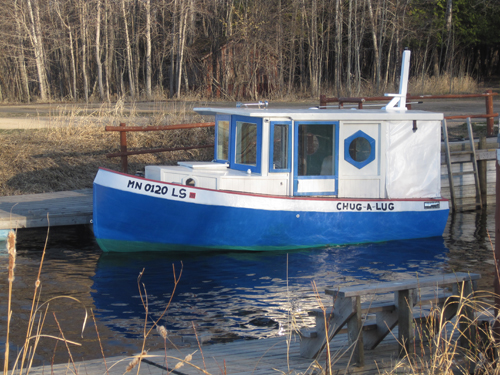
Yep, the sign did say the max beam it can take is 72″. But if they follow through on the planned de-commissioning, I guess that doesn’t matter too much.
Hi Tom,
I just finished reading your adventure story to my wife, who is healing from cancer, and wanted a distraction from some discomfort she was feeling before bedtime. She asked for a story. I had wanted to read yours for many weeks now and it was just what we needed. Although we haven’t done much boating, for a short time, we were traveling with you. Very enjoyable, and as the story ended, my wife drifted gently off to sleep. Many thanks!
Shawn,
Thanks so much for your note here. My mom is a cancer survivor, as was my dad, so it’s really meaningful to hear that my story has offered some small part of what you and your wife needed at the moment. Best wishes for the rest of the journey–may it go smoothly, with time to enjoy everything along the way, and plenty of rest when you need it.
Tom
Hi! Love the look and stability of your boat, and the lug rig.
I’m wondering if there is any advantage to the one you have vs. a balanced lug sail and why you chose the one you did.
Frank, I’m sorry for the late reply, but hopefully you’ll get a chance to read it if you’re still interested. Here goes:
I would say a boomless standing lug vs. a balance lug with a boom is not so much a question of advantages, but one of trade-offs and compromises. A boomless rig doesn’t allow you to sail dead downwind the way a boomed rig does, and sheet angles are critical for performance (generally as far aft and outboard as possible–no center sheeting!).
The trade-off is, one less spar to build and stow and handle, and one less spar to hit passengers. I have used both balance lugs and boomless standing lugs, and have come to prefer the boomless rig for myself. Less control of sail shape is possible, so a boomless rig enables lazy sailing (no need to constantly tweak sail shape). But another trade-off is, the twist that happens in the head of the sail automatically depowers the sail, which can be somewhat of a safety feature. Basically, I think of the boomless standing lugsail as a rig that pretty much disallows “Type A” behavior. I like that, as I am pretty much a “Type Z” sailor. 🙂
Tom
I miss Tom’s stories.
John,
Thanks for the comment–that’s very kind to say. Life gets in the way at times, but I’m hopeful that I’ll have some more boat-related stories to tell before too long. It’s always nice to know my writing is appreciated!
Tom